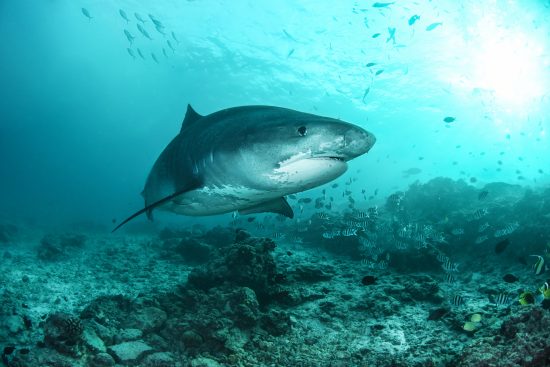






Tiger Sharks are one of the largest predatory sharks, shadowed only by the Great White. Female Tiger Sharks are larger in size than their male counterparts and are usually around 4 meters (13ft) long.
They can be found all around the world, in tropical/warm-temperate seas. Records show that they occasionally do deep dives (down to 350 meters), but they seem to be most comfortable dwelling in murky waters in coastal areas. Tiger Sharks can also be found in lagoons and coral atolls around large island chains and often migrate between the islands.
Tiger Sharks start their life cycle in quite an unusual way. Fertilized eggs are hatched within a brood chamber in a female shark's body and nourished by the egg yolk until they are fully developed. Once the embryos are fully grown, the female can give birth to anywhere from 10 to 82 live pups.
Juvenile Tiger Sharks have distinct tiger-like patterns on their body. As they are less than 1 meter (3ft) long when they are born, they are vulnerable to various predators until they reach their full size and earn a formidable reputation as top predators in their habitats. The tiger stripes closely resemble the shadows of the waves, so the young Tiger Sharks tend to stay close to the sea surface, blending in with the environment.
You have probably heard of the phrase “A tiger cannot change its stripes”, however, Tiger Sharks can. The tiger-like pattern on their bodies slowly fades as they reach maturity, becoming almost unrecognizable in fully grown adults.
Tiger Sharks are solitary night hunters that have mastered an awareness of their surroundings. Unlike our eyes, tiger sharks’ eyes (and those of sharks in general) do not have eyelids, however, they do possess a nictitating membrane, a clear eyelid-like structure that can cover the eye and protect it when sharks are attacking their prey. Like many nocturnal predators, Tiger Sharks have a reflective layer behind the retina, called the tapetum lucidum. This enables them to capture even the slightest glimmer of light and enhance their night vision. The knowledge about the uniqueness of the shark eyes seems to predate modern science as some native Hawaiians consider Tiger Sharks sacred na ʻaumakua (ancestor spirits) and attribute their eyeballs special powers of visual perception.
Besides excellent night vision and a keen sense of smell, Tiger Sharks rely heavily on specialized receptors in their snout, called the ampullae of Lorenzini, that can detect electric impulses. Electricity is the main means of communication in muscle and nerve cells of all animals, so these sharks can detect the smallest muscle movement and even their prey’s heartbeat.
Additionally, sharks also possess an extraordinary organ along the side of their bodies, called the lateral line, which helps them detect vibrations in the water. Therefore, any movement or disturbance of the water does not go undetected for the tigers of the sea.Once it locks in on its prey, this shark utilizes its last weapon, a powerful jaw full of unique sailboat-like teeth with sideways pointing tips.
Tiger Sharks have one of the most versatile diets in the marine world, consisting of fish, sea snakes, seals, jellyfish, birds, squids, turtles, dolphins, and even other smaller sharks. They seem to not care too much about the taste of their food, as many records show that they often ingest man-made objects (sea litter) such as license plates, old tires etc.
It is hard to imagine that any other marine predator would even dream of preying on an adult Tiger Shark given its remarkable size and sharp senses, however, evidence shows that they are occasionally hunted by Orcas/Killer Whales. Killer Whales are, on average, slightly larger and substantially heavier than a fully grown Tiger Shark, however, it is not the brute force that gives them an advantage over a shark. Orcas hunt in highly organized pods that actively communicate and pass down a knowledge of hunting techniques and the prey’s weaknesses. Like many other sharks, Tiger Sharks, if turned upside down, become paralized in a state called Tonic Immobility (a technique often used in shark handling). Orcas, aware of this strange weakness of the sharks, attack them, immobilize them and feed on their nutritious livers with almost surgical precision.
Tiger Sharks are often labeled as dangerous man-eating beasts, but unprovoked attacks on humans are quite rare and rarely fatal. On the other hand, Tiger Sharks are considered near threatened on the IUCN Red List. They are hunted for their fins, flesh and liver rich in vitamin A, or marketed as an extravagant catch in big game fishing. Even when not targeted directly, they are in danger of ending up as bycatch in commercial and recreational fisheries worldwide.
For more information about diving with Tiger Sharks, see Fuvahmulah Scuba Club in the Maldives and Irina Britanova's Instagram page.
Written by Lena Ilic, Bachelor of Science, Marine Biologist
Photos by Ivana OK and Janez Kranjc
If you're interested in learning even more about Sharks, why not check out the Shark Ecology course from our friends at SSI?
 Ivana and Janez
Ivana and Janez 15th December 2021
15th December 2021